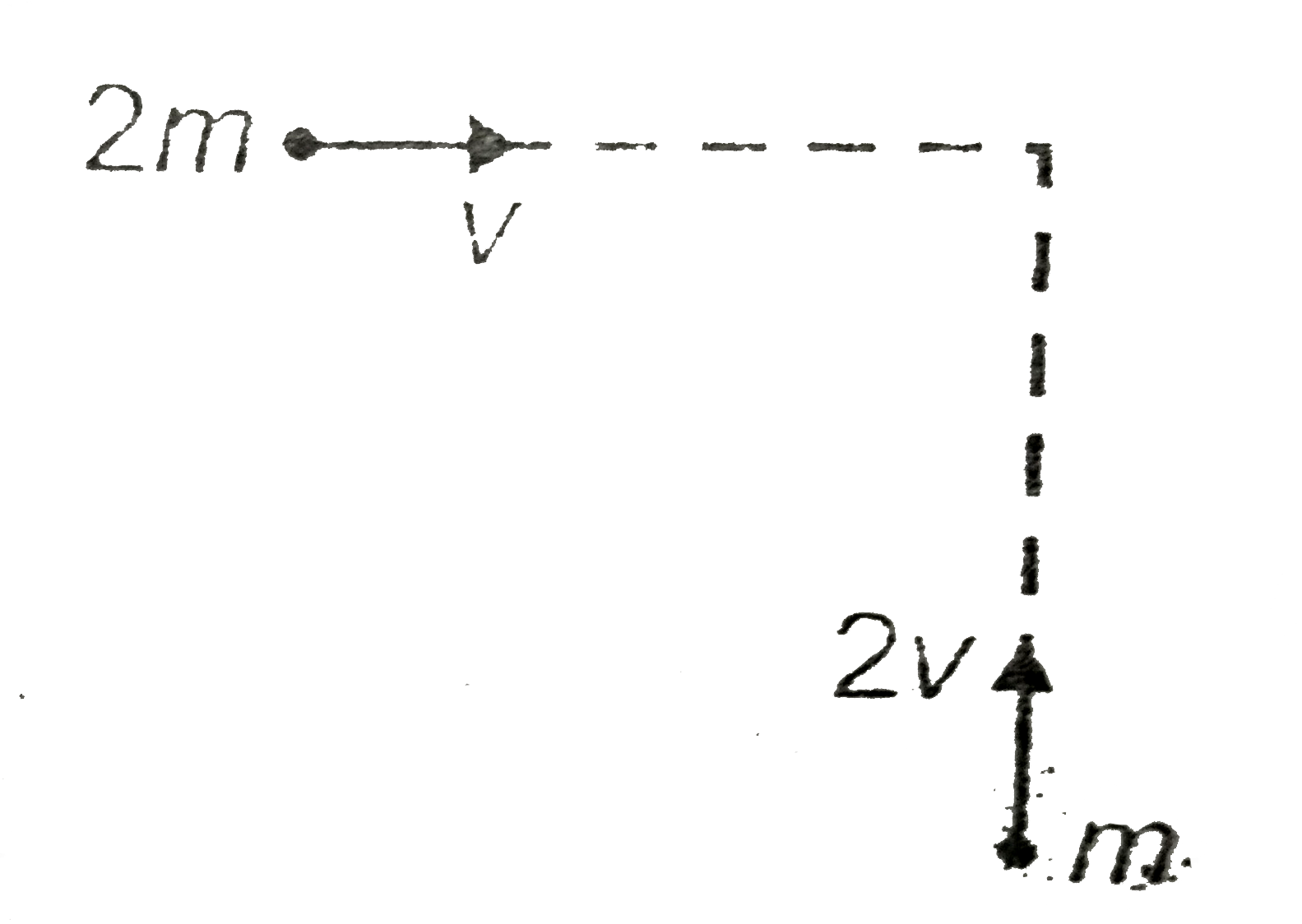A particle of mass m moving in the x direction with speed 2v is hit by another particle of mass 2m moving in they y direction with speed v. If the collision is perfectly inelastic, the percentage loss in the energy during the collision is close to :
50%
56%
62%
44%
The correct Answer is:B
To solve the problem, we need to calculate the percentage loss in kinetic energy during a perfectly inelastic collision between two particles. Here are the steps to arrive at the solution:
Step 1: Identify the initial kinetic energies of both particles.
- The first particle has mass m and speed 2v:
KE1=12m(2v)2=12m⋅4v2=2mv2
- The second particle has mass 2m and speed v:
KE2=12(2m)v2=mv2
Step 2: Calculate the total initial kinetic energy.
KEinitial=KE1+KE2=2mv2+mv2=3mv2
Step 3: Apply conservation of momentum to find the final velocity after the collision.
- The momentum in the x-direction before the collision:
Px,initial=m⋅2v+0=2mv
- The momentum in the y-direction before the collision:
Py,initial=0+2m⋅v=2mv
After the collision, the two particles stick together, so the total mass is 3m. Let Vf be the final velocity vector. By conservation of momentum:
- In the x-direction:
2mv=3mVfx⟹Vfx=23v
- In the y-direction:
2mv=3mVfy⟹Vfy=23v
Step 4: Calculate the magnitude of the final velocity.
Using the Pythagorean theorem:
Vf=√V2fx+V2fy=√(23v)2+(23v)2=√2⋅(23v)2=2v3√2
Step 5: Calculate the final kinetic energy.
KEfinal=12(3m)V2f=12(3m)(2v3√2)2=12(3m)⋅8v29=4mv23
Step 6: Calculate the percentage loss in kinetic energy.
Loss in KE=KEinitial−KEfinal=3mv2−4mv23=9mv23−4mv23=5mv23
Now, the percentage loss in kinetic energy is given by:
Percentage loss=Loss in KEKEinitial×100=5mv233mv2×100=59×100≈55.56%
Final Answer
The percentage loss in kinetic energy during the collision is approximately 56%.
---
- The first particle has mass m and speed 2v:
KE1=12m(2v)2=12m⋅4v2=2mv2
KE2=12(2m)v2=mv2
KEinitial=KE1+KE2=2mv2+mv2=3mv2
- The momentum in the x-direction before the collision:
Px,initial=m⋅2v+0=2mv
- The momentum in the y-direction before the collision:
Py,initial=0+2m⋅v=2mv
- In the x-direction:
2mv=3mVfx⟹Vfx=23v
- In the y-direction:
2mv=3mVfy⟹Vfy=23v
Using the Pythagorean theorem:
Vf=√V2fx+V2fy=√(23v)2+(23v)2=√2⋅(23v)2=2v3√2
KEfinal=12(3m)V2f=12(3m)(2v3√2)2=12(3m)⋅8v29=4mv23
Loss in KE=KEinitial−KEfinal=3mv2−4mv23=9mv23−4mv23=5mv23
Percentage loss=Loss in KEKEinitial×100=5mv233mv2×100=59×100≈55.56%
The percentage loss in kinetic energy during the collision is approximately 56%.
Topper's Solved these Questions
Similar Questions
A particle of mass m moving with speed u collides perfectly inelastically with another particle of mass 3 m at rest. Loss of KE of system in the collision is
View SolutionA particle of mass m moving with speed u collides perfectly inelastically with another particle of mass 2m at rest. Find loss of kinetic energy of system in the collision.
View Solution
Knowledge Check
Two objects, one of mass 3 kg and moving with speed of 2 m/s and the other of mass 5 kg and speed 2 m/s, move toward each other and collide head-on. If the collision is perfectly inelastic, find the speed of the object after the collision.
A0.25m/sB0.5m/sC0.75m/sD1m/s
A particle of mass m moving with speed u collides perfectly inelastically with another particle of mass 2m at rest. Find loss of kinetic energy of system in the collision.
View SolutionTwo particles of mass 2m and m moving with speed v and 2v respectively pependicular to each other collides perfectly inelastically, then

Speed of the particles after collision
View Solution(b) Two balls each of mass m moving in opposite direction with equal speed v collide head -on with each other . Predict the outcome of the collision assuming it perfectly elastic.
View SolutionA particle of mass m moving towards west with speed v collides with another particle of mass m movies towards south. If two particles st ich t o each other the speed of the new particle of mass 2 m will be
View SolutionA particle of mass m moving with speed V collides elastically with another particle of mass 2m. Find speed of smaller mass after head on collision
View SolutionA particle of mass 2m moving with velocity v strikes a stationary particle of mass 3m and sticks to it . The speed of the system will be
View SolutionA ball of mass 5 kg moving with speed 8 m/s collides head on with another stationary ball of mass 15 kg. If collision is perfectly inelastic, then loss in kinetic energ is
View Solution
